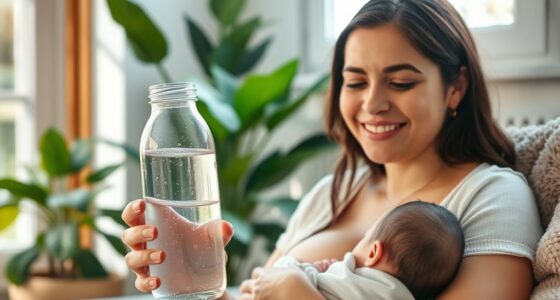Postpartum hair loss is a common, temporary condition caused by hormonal shifts after pregnancy, mainly due to a drop in estrogen levels. Your shedding usually begins around three to four months and peaks by the fourth month, with hair growth typically restarting within a year. Proper nutrition, gentle care, and patience support recovery, but if you notice severe or persistent loss, seeking medical advice is important. To understand more about managing and speeding up your postpartum hair return, keep exploring the key facts.
Key Takeaways
- Postpartum hair loss typically begins around 3-4 months after childbirth due to hormonal changes.
- Shedding is normal and usually peaks by the fourth month, with hair regrowth starting within 6-12 months.
- Nutrients like biotin, iron, omega-3s, and protein support faster hair recovery.
- Gentle hair care, avoiding heat styling, and regular nourishing masks promote healthy regrowth.
- Seek medical advice if shedding persists beyond a year or if there are patchy bald spots or scalp issues.
Understanding Postpartum Hair Loss
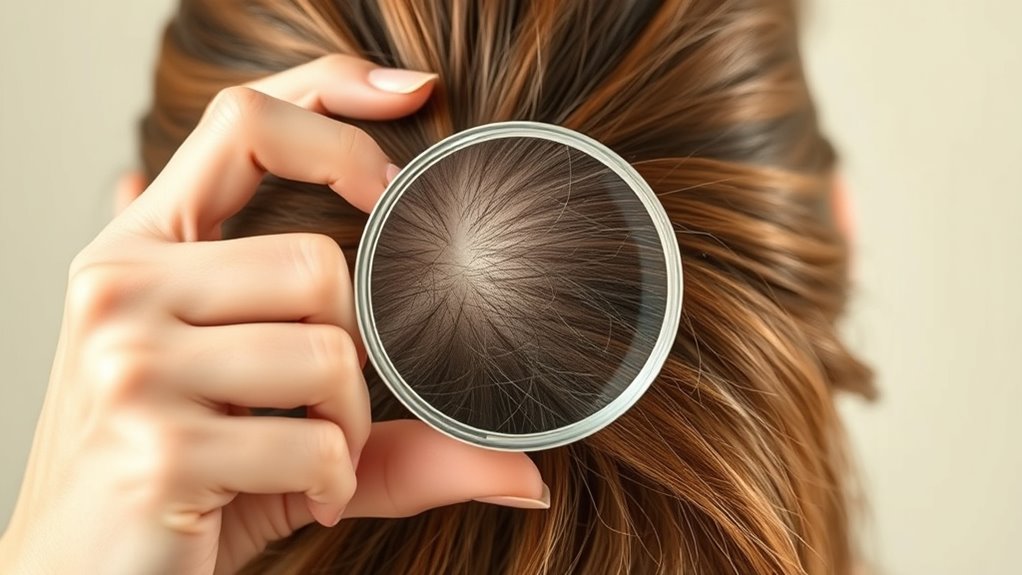
Postpartum hair loss is a common experience that many new mothers face, usually occurring within a few months after childbirth. It happens because your body is adjusting hormone levels, especially the drop in estrogen that supported hair growth during pregnancy. During pregnancy, increased estrogen keeps more hair in the growth phase, leading to thicker, fuller hair. After delivery, estrogen levels decrease, and your hair naturally sheds to return to pre-pregnancy levels. This shedding can seem sudden and noticeable but is a normal part of your body’s recovery process. It doesn’t mean your hair is permanently damaged; rather, your hair cycle is adjusting. Expect some shedding, but know that it’s temporary, and your hair will typically regrow over time. Understanding hormone fluctuations plays a crucial role in managing expectations during this transitional period.
The Causes Behind Hair Shedding After Birth

The main cause of hair shedding after birth is the rapid decline in estrogen levels that occurred during pregnancy. This hormonal shift signals your hair to exit the growth phase, leading to noticeable thinning. You might feel overwhelmed as your once-thick hair becomes sparse, making you question if it will ever return to normal. It’s a natural, temporary process, but it can still be distressing. Additionally, some women may experience increased hair loss due to air purifier technologies that help improve overall indoor air quality, which can support healthier hair growth during recovery. Here are some factors that contribute to postpartum shedding: 1. Sudden hormone drop that disrupts hair growth cycles 2. Stress and fatigue weaken hair follicles and accelerate shedding 3. Nutritional deficits from postpartum recovery impact hair health 4. Sleep deprivation hampers your body’s ability to repair and regenerate hair strands
Postpartum hair shedding is a natural, temporary response to hormonal decline after pregnancy.
Understanding these causes can help you navigate this challenging phase with patience.
How Hormonal Changes Impact Hair Growth
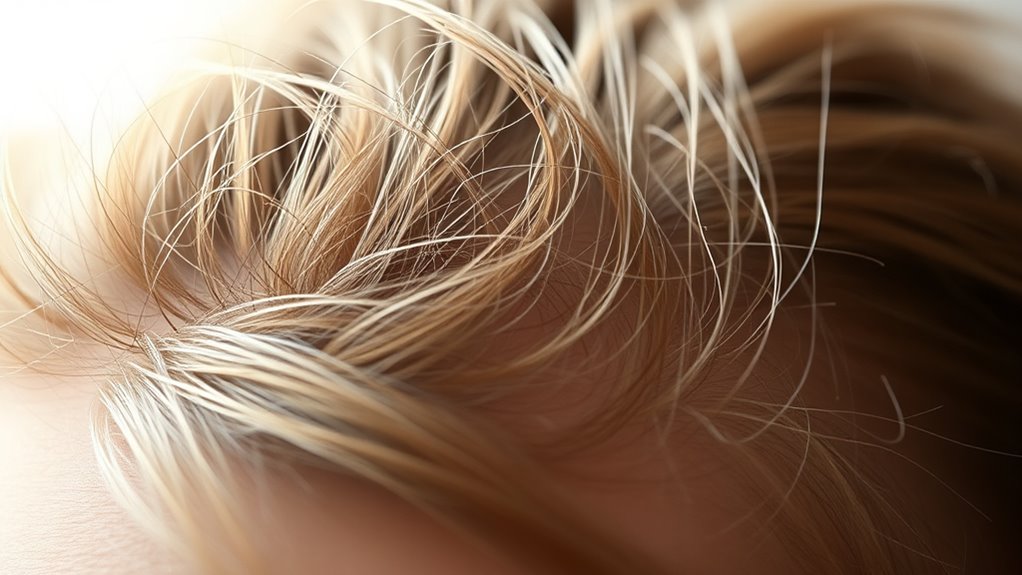
Hormonal fluctuations after pregnancy can cause noticeable changes in your hair growth. Your levels of hormones like estrogen and progesterone influence how much hair you shed or retain. Additionally, thyroid function plays a key role, and imbalances can further impact the health of your hair.
Hormonal Fluctuations and Hair Loss
When hormone levels fluctuate dramatically after childbirth, they can substantially disrupt your hair growth cycle. This sudden change causes hair follicles to enter the resting phase, leading to increased shedding. You might feel overwhelmed watching your hair thin unexpectedly. Here are four emotional impacts of hormonal shifts:
- Feeling self-conscious about your changing appearance.
- Frustration over the loss of your usual confidence.
- Anxiety about how long it will take to regain your hair’s fullness.
- Hopelessness when results seem slow or unseen.
These hormonal swings can make you feel like you’re losing control. Remember, this is temporary. Your body is adjusting, and with time, your hair will often start to recover. Staying informed about hair loss factors can help you better understand the process. Stay patient and gentle with yourself during this process.
Thyroid Function and Postpartum
After childbirth, your thyroid gland can become less efficient, leading to hormonal imbalances that affect your hair growth. When your thyroid slows down, it reduces the production of hormones essential for hair follicle health. This imbalance can cause hair to thin or shed more than usual, adding to postpartum hair loss concerns. It’s common for thyroid function to fluctuate during this period, but persistent issues may signal hypothyroidism. If you notice excessive hair loss, fatigue, or weight changes, it’s important to get your thyroid levels checked. Restoring thyroid health often involves medication or lifestyle adjustments, which can help regulate hormone levels and support healthier hair growth. Managing your thyroid function is vital for recovering your hair’s strength and preventing ongoing loss. Ensuring proper thyroid function is crucial, as vetted information highlights its significant impact on hormonal balance and hair health.
The Typical Timeline of Postpartum Hair Loss
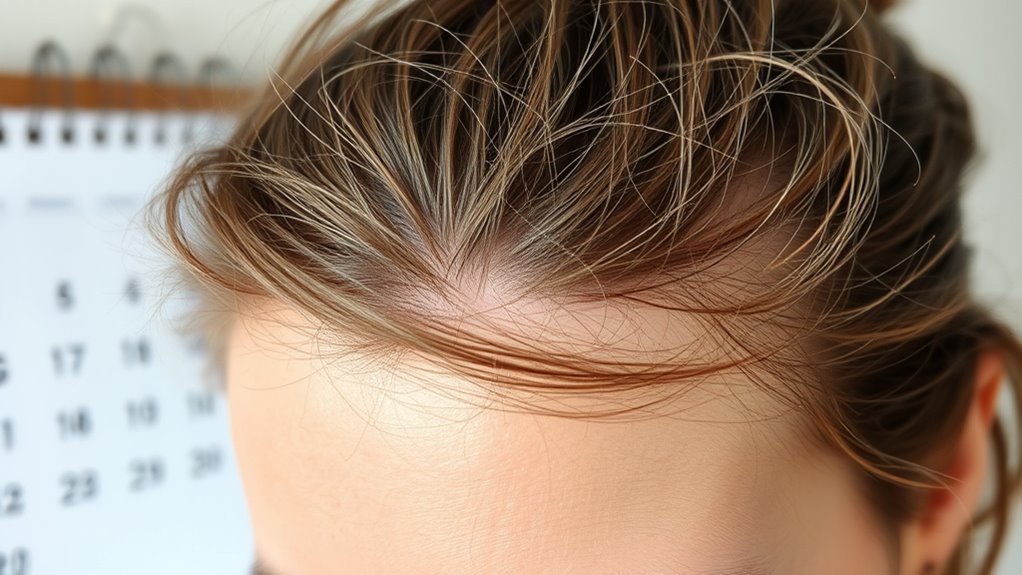
The typical timeline of postpartum hair loss usually begins around three to four months after delivery, catching many new mothers by surprise. During this period, you might notice increased shedding and thinning, which can feel alarming. Here’s what to expect:
- Peak Shedding: Around month four, you may see a significant amount of hair falling out, making you worry about your appearance.
- Emotional Rollercoaster: This sudden change can cause feelings of frustration and self-consciousness.
- Temporary Anxiety: You might wonder if this loss is permanent, adding stress to your postpartum experience.
- Gradual Recovery: By six to twelve months, hair usually begins to regrow, restoring your confidence and comfort.
- Understanding Hair Regrowth can help reassure you that this shedding is a normal part of your body’s recovery process.
Differentiating Between Normal Hair Loss and Other Conditions
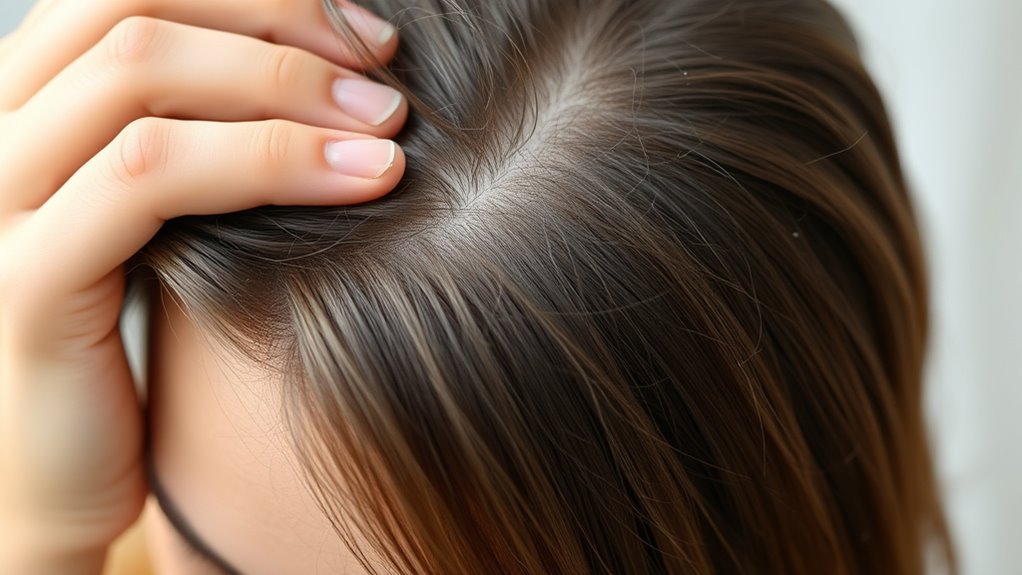
While postpartum hair loss is common and typically temporary, it’s important to recognize when it might signal a different condition. Normal postpartum shedding usually involves diffuse thinning across your scalp, with hair returning to normal within a year. However, if you notice sudden, patchy hair loss or excessive shedding beyond the usual postpartum period, it could indicate another issue. Here’s a quick comparison:
| Normal Postpartum Hair Loss | Other Conditions |
|---|---|
| Diffuse thinning | Patchy or uneven hair loss |
| Gradual hair regrowth | Rapid hair shedding or bald spots |
| Occurs within months postpartum | Persistent beyond a year |
Additionally, understanding crochet styles for locs can be helpful for those seeking protective styling options during recovery.
If symptoms diverge from this pattern, consult a healthcare professional to determine the cause.
Nutritional Factors That Support Hair Health

Proper nutrition plays a crucial role in maintaining healthy hair, especially during the postpartum period when your body is recovering and adapting. When you nourish your body with the right nutrients, you support hair growth and reduce shedding. Focus on foods rich in essential vitamins and minerals.
Here are four key nutritional factors to boost your hair health:
- Biotin: Strengthens hair strands and promotes growth.
- Iron: Prevents thinning by improving oxygen flow to hair follicles.
- Omega-3 Fatty Acids: Nourish scalp and reduce inflammation.
- Protein: Builds the keratin your hair needs to stay strong.
Additionally, incorporating cooking red lentils can provide a plant-based source of protein and iron, which are vital for healthy hair.
Effective Hair Care Tips During Recovery

To support your hair recovery, start by using gentle shampoo techniques to avoid unnecessary stress on your strands. Incorporate nourishing hair masks regularly to boost strength and moisture. Also, try to minimize heat styling to prevent damage during this delicate phase. Additionally, consider adaptive hair care techniques that respond to your changing hair needs throughout postpartum recovery.
Gentle Shampoo Techniques
During postpartum recovery, using gentle shampoo techniques can make a significant difference in reducing further hair stress. You want to protect your delicate strands while cleansing. To do this:
- Use lukewarm water instead of hot, which can strip moisture and weaken hair.
- Apply shampoo gently with your fingertips, avoiding harsh rubbing or scratching.
- Focus on your scalp, massaging softly to stimulate circulation without causing damage.
- Rinse thoroughly to remove all product residue, preventing buildup that can weigh hair down.
- Consistently gentle hair care practices will help maintain your hair’s health and support growth during recovery.
These simple steps help minimize stress on your hair follicles, promoting healthier growth during recovery. Remember, handling your hair gently is key to reducing breakage and supporting your body’s natural healing process.
Nourishing Hair Masks
Nourishing hair masks can provide essential nutrients that support hair strength and promote faster recovery postpartum. By applying these masks regularly, you help deliver vitamins, proteins, and antioxidants directly to your scalp and hair strands. Look for masks containing ingredients like coconut oil, argan oil, honey, or aloe vera, which hydrate and nourish your hair deeply. These masks can reduce breakage, improve elasticity, and encourage healthier growth. To maximize benefits, apply the mask to damp hair and leave it on for 20-30 minutes before rinsing thoroughly. Incorporating a nourishing mask into your routine a couple of times a week can restore moisture, strengthen fragile strands, and give your hair the extra care it needs during this recovery phase. Additionally, choosing tuning techniques suited for your hair type can further enhance hair health and resilience.
Minimize Heat Styling
Since heat styling tools can weaken and further damage your delicate postpartum hair, it’s essential to limit their use. Excessive heat can lead to breakage, frizz, and slow down recovery. To protect your hair during this time, consider these tips:
- Embrace Air-Drying: Let your hair dry naturally to avoid unnecessary heat exposure.
- Use Heat Protectants: Always apply a heat protectant spray before styling with any hot tools.
- Limit Frequency: Reserve heat styling for special occasions, and give your hair a break in between.
- Opt for Gentle Styles: Choose low-heat or no-heat hairstyles to minimize stress on your strands.
When to Seek Medical Advice
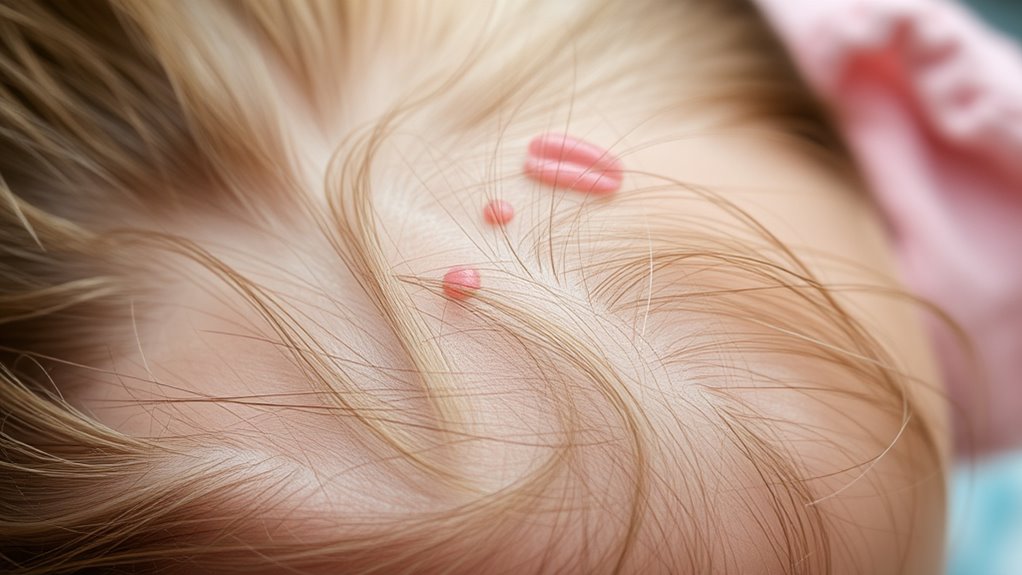
If you notice your postpartum hair loss is severe, persistent, or worsening beyond a few months, it’s important to consult a healthcare professional. Significant hair loss that leaves bald patches or causes noticeable thinning shouldn’t be ignored. You should also seek medical advice if you experience other symptoms like scalp pain, redness, itching, or inflammation. These could indicate underlying conditions such as infections or hormonal imbalances that need treatment. Additionally, if your hair loss is affecting your emotional well-being or causing distress, a healthcare provider can help identify the cause and recommend appropriate solutions. Remember, while postpartum hair loss is common, persistent or severe cases warrant professional evaluation to rule out other health issues.
Long-Term Hair Growth Expectations
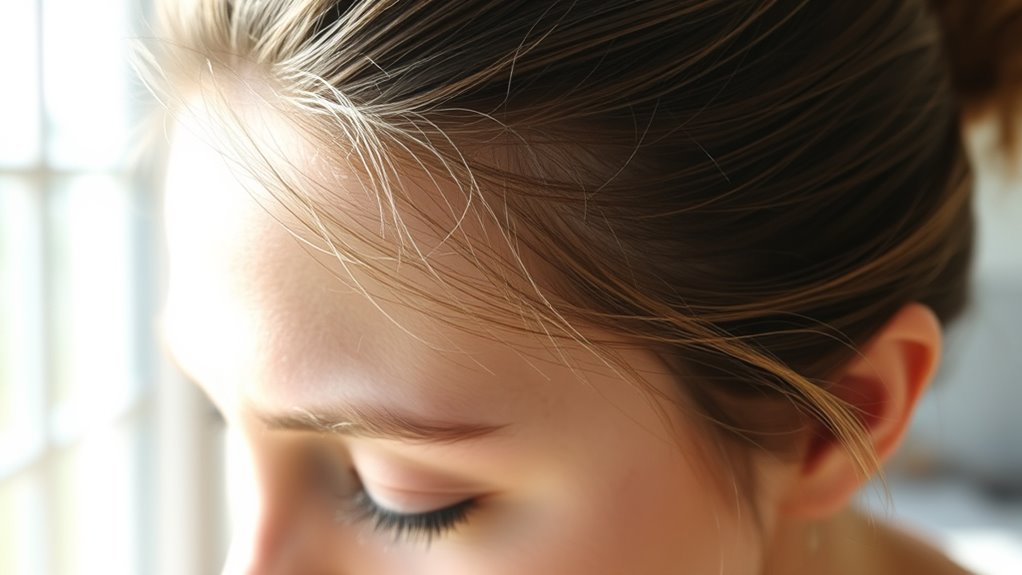
After addressing immediate concerns about severe or persistent hair loss, understanding what to expect in the long run can help ease worries. Typically, your hair will gradually return to its pre-pregnancy thickness within 6 to 12 months. You might experience periods of slower growth or temporary thinning, but these are normal. Patience is key, and your hair’s natural cycle will restore fullness over time.
Here are some things to keep in mind:
- Your hair may take up to a year to fully recover.
- New growth might be finer initially but will thicken with time.
- Hair shedding can fluctuate, but it’s part of the healing process.
- Consistent scalp care and a healthy diet support ideal regrowth.
Frequently Asked Questions
Can Postpartum Hair Loss Be Prevented?
You might wonder if postpartum hair loss can be prevented. While it’s a common and natural part of postpartum recovery, you can take steps to minimize its impact. Eating a balanced diet, staying hydrated, and managing stress can support healthy hair growth. Avoid harsh hair treatments, and use gentle shampoos. Although you can’t fully prevent postpartum hair loss, these habits can help you maintain healthier hair during this evolutive phase.
Does Postpartum Hair Loss Affect Hair Quality?
Postpartum hair loss can cause changes in your hair’s texture and strength. As your hormones fluctuate, your hair might become thinner, more brittle, or less lustrous. While it doesn’t usually impact the overall quality permanently, you may notice temporary dullness or dryness. You can support healthy hair by maintaining a balanced diet, staying hydrated, and avoiding harsh treatments. Remember, your hair’s quality typically recovers as hormone levels stabilize.
Are Certain Hairstyles Better During Postpartum Recovery?
During postpartum recovery, choosing gentle hairstyles can make a big difference. You should avoid tight ponytails, braids, or buns that pull on your hair and cause stress. Instead, opt for loose styles, soft clips, or headbands that don’t tug. These options help reduce tension on your scalp, promote healthy hair growth, and keep your hair looking good while your body heals. Be kind to your hair during this important time.
How Does Postpartum Hair Loss Differ From Alopecia?
Postpartum hair loss happens due to hormonal shifts after childbirth, leading to increased shedding that usually resolves within months. Alopecia, however, is a medical condition causing more significant, often permanent hair loss. You might notice differences in pattern and severity. While postpartum shedding is temporary, alopecia requires medical attention. Recognizing these differences helps you decide when to seek professional advice and manage your hair health effectively during recovery.
Can Postpartum Hair Loss Be Permanent?
You’re wondering if postpartum hair loss can be permanent. Generally, it’s temporary and your hair should grow back within several months after childbirth. Hormonal changes cause the shedding, but once your hormone levels stabilize, your hair growth usually resumes normally. However, if hair loss persists beyond a year or worsens, it’s wise to consult a healthcare professional to rule out other underlying issues. Rest assured, most women experience full recovery.
Conclusion
Remember, postpartum hair loss is like a temporary storm passing through your life’s garden. With patience, nourishing your body, and gentle care, your hair will bloom again, stronger and more vibrant. Trust the process, and don’t be discouraged by the shedding—it’s just nature’s way of making space for new growth. Soon enough, your hair will flourish, catching the sunlight like a field of wildflowers in full bloom.





